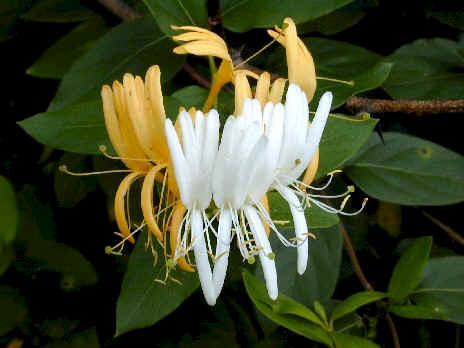| Lonicera japonica | |
|
Japanese Honeysuckle
|
|
| Origin Ff Species | |
| Japan | |
| Physical Description | |
| Japanese honeysuckle is a semi-evergreen trailing or climbing vine that can reach eighty feet in length. The brown stem is slender and covered with fine hairs. The small opposite leaves are elliptic or oblong with round bases and pointed tips. Flowers occur between April and June and form pairs on stalks. The thin tubular flowers may be white, pink, or yellow and possess five lobes, four upper and one lower. Between August and March, black fruits form. | |
| Habitat And Distribution | |
| Japanese honeysuckle often climbs to form a forest canopy or creeps to form groundcover. It is also found at disturbed habitats such as forest margins, roadsides, trails, fencerows, and abandoned fields. Japanese honeysuckle is prevalent in every state within the United States, including Alaska and Hawaii. | |
| Location On Campus | |
| Japanese honeysuckle is abundantly present along wooded areas on campus. | |
| Negative Impacts | |
| Japanese honeysuckle can survive in a variety of habitats, overwhelming native vegetation in forest canopies and as groundcover. | |
| VDCR Invasiveness Ranking | |
| Highly Invasive Species Additional Images: Flowers with stem and leaves on another plant Flowers with stem and leaves Flowers with stem and leaves on another plant Vine |
|
